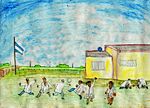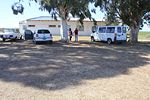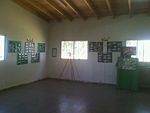Rural school of San Eduardo
Rural school of San Eduardo and around, Trenque Lauquen, Argentina
Short Introduction to the Area of Study
The area under study is located in the center of Argentina in a plain area of big farms devoted to agriculture, livestock and milk production. It is a very well communicated area through a net of dirt and paved roads. In the middle of a productive landscape, the rural school of San Eduardo is a meeting point, a landmark, a meeting place for adults and the only place where the sons and daughters of rural workers can get education.
This area is important to me because I have worked in a farm and in the school in the coordination of a Rural Development Project through which twenty women were trained to generate handcrafts small enterprises. Now, I am doing my Doctorate research in Anthropology, where I explore how children and women living in the area see and feel their everyday landscape.
Exercise 1: Sketching the Landscape
Time frame: October 25 - November 15, 2011
Student activities:
- Creation of analytical drawings and sketches
- Presentation of results
Please upload a selection of your drawings/sketches/mental maps and add them to the image gallery
Sketches and Drawings
Exercise 2: Landscape Layers
Time frame: November 15 - 29, 2011
- time based changes and 'landscape biography', and/or:
- topography, open spaces, built, green, traffic and water structures on different layers. *Definition of zones with coherent character
- Description of this character.
Please publish your findings here
Exercise 3: Behaviour Patterns
Time frame: December 6 - 20, 2011
- How do people behave in this area? How do they use the space? What is important for them?
- Observation of study area, interviews with local people and mapping of use patterns.
- Preparation of short presentation
Please publish your findings here
- How do people behave in this area? How do they use the space? What is important for them?
The school of San Eduardo has around 28 pupils and most of them (80%) live in the farms. They go from home to the school by moto, horse, by walking and by a mini bus (see pictures). In summer they go to the school in the mornings and in winter they go in the afternoons. Out of these times the school is empty unless there are some adult capacitation at night. In farms, land is devoted to soybean production, cattle for milk production, and horse (for instance horses to play polo). The use of the space depends on the kind of production, the season, the weather, the size of the farm and general economic conditions.
Workers devoted to animal production live in the farms, the farm owner live in the city as people that is devoted to agriculture. They travel everyday from the farms to the city and the other way around. There is a high use of the roads, in cars, trucks and agricultural machines specially during the day. In winter it is possible to find hunters of wild rubbits during the night that go very slowly by the road.
For all of them is very important the state of the road, to have a good road to get into the city and back home.
Observation of study area, interviews with local people and mapping of use patterns.
I did a fiel research during November with 10 pupils of the school. One of the activities was a worshops of photogrpahy by which they took pictures of the school, the travel they do everyday and took pictures at their home place. I could observe through their pictures their everyday landscapes and how they get to school (see pictures). I talked to the teachers and with the driver man of the mini bus who is colllecting the girls and boys in the entrance of the farms. From there, they go home by horse, bike, walking or their parents wait for them in a car.
Besides, I know how people work and manage the farms because I have worked in the area for almost ten years. I know that the use of the internal space of the farms depends on the prduction and the crops. In general it could be said that there is more agriculture, that tere is a tendency to take out the fences to have bigger plots to make agriculture, that there is less animals and they are brought to the lowest parts of the fields where it is not possible to make agrioculture because of the worst quality of land.
There are big machines which do the work very quickly and leave the farm very soon to go to another farm. There is a lot of pulverization, and as a consequence many trees and wild vegetation are dying because of the use of herbicides. Few people live in the farms comared to 20 years and they do not receive much atention from the argentinean authorities.
- 2AG.jpg
your image text
- 3AG.jpg
your image text
Exercise 4: Communication Concepts
Time frame: December 19, 2011 - January 17, 2012
- Based on the different landscape assessment approaches students will develop a communication concept for their area of study
- Which measures would be necessary for enhancing the awareness for the area?
- Students are free to choose their method.
The landscape of rural Trenque Lauquen has undergone major transformations since 2002, when genetically modified soy was introduced in the area jointly with a whole technological package. It is based on the use of transgenic seeds and a high use of agrochemicals that are applied by ground or by aircraft machines. This practice is not always done in optimal weather conditions, for example they are applied on windy days and the chemical crop deviates and reaches other surrounding areas, reaching in many cases the houses. Sometimes, planes fly too close to houses and rural schools. As a result, it is now possible to see many dead trees surrounding homes and health problems of people who live there, such as breathing problems or allergies.
Besides, another consequence of this change is that they have gone productive livestock production that required more people to your attention that agriculture, and this has led to depopulation of the area.
As a result, some people begins to speak and conceptualized the area as a green desert, which encourages the area to work without caring for people, especially the irresponsible use of agrochemicals. Also, rural schools have fewer students and endangered its continuance.
For these reasons, it is essential to reverse the idea that the area is a desert because there are people working and living there, who has to be provided with education and protection For this reason, people and their ordinary landscapes has to be known. Some communication strategies to raise awareness about the mentioned facts have been developed.
1. Create a Photography Exhibition to be shown at different urban locations and other rural schools. The first exhibition was in December 2011 at the Rural School of San Eduardo and it has been made with pictures that had been taken by students of the schoool during the month of November 2011 in a Photography Workshop. During the days of the workshop children have photographed their school, their journey from school to home and their homes. The aim was to show their everyday landscapes, themselves living in the countryside and being educated at a Rural school (see pictures 1 to 6)
2. Make cards with the pictures of students at school and at home. The aim is to distribute images to different institutions and people in charge of the use of chemical products in agriculture(see pictures 7 to 10)
3. Make a website where you compile the history of the place, which is already under construction (www.ordinarylandscapes.com)
Image Gallery
References
* Please make sure that you give proper references of all external resources used.
* Do not use images of which you do not hold the copyright.
* Please add internet links to other resources if necessary.
About categories: You can add more categories with this tag: "", add your categories

































